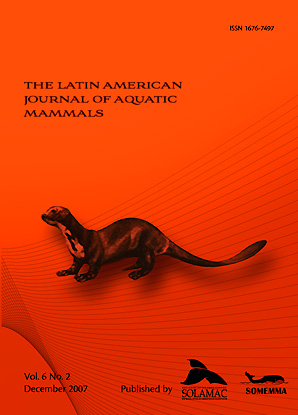Age estimation in giant otters (<i>Pteronura brasiliensis</i>) (Carnivora: Mustelidae) using growth layer groups in canine teeth
DOI:
https://doi.org/10.5597/lajam00120Abstract
The canines of six giant otters Pteronura brasiliensis (5 males and 1 female) from the zoological collection of the National Institute of Amazonian Research (INPA) were analyzed for age estimation. Of these, two were from known-age individuals of 2 and 5 years. Ages were read counting the Growth Layer Groups (GLGs) observed in thin sections (30μm) of decalcified teeth. GLGs were present in the dentine but were not conspicuous; age estimates were only reliable when counted in the cementum. Periodicity of GLGs and age estimates were calibrated with the known-age individuals. Results revealed an annual deposition pattern of GLGs in the cementum of giant otter canines, and no apparent differences were found in the GLG patterns observed between males and females, or between captive and free-ranging individuals. The youngest and oldest giant otters analyzed were 2 and 20 years old, respectively. These results suggest that the longevity of captive giant otters is around 20 years. The age determination technique applied here proved to be useful for age estimation in giant otters and can contribute as a powerful tool for future studies on the population dynamics of P. brasiliensis, which is currently classified as endangered.Downloads
Published
2007-12-31
How to Cite
Oliveira, G. C., Barcellos, J. F. M., & Rosas, F. C. W. (2007). Age estimation in giant otters (<i>Pteronura brasiliensis</i>) (Carnivora: Mustelidae) using growth layer groups in canine teeth. Latin American Journal of Aquatic Mammals, 6(2), 155-160. https://doi.org/10.5597/lajam00120
Issue
Section
Articles
License
Authors who publish with this journal agree to the following terms:- Authors retain copyright and grant the journal right of first publication with the work simultaneously licensed under a Creative Commons Attribution License that allows others to share the work with an acknowledgement of the work's authorship and initial publication in this journal.
- Authors are able to enter into separate, additional contractual arrangements for the non-exclusive distribution of the journal's published version of the work (e.g., post it to an institutional repository or publish it in a book), with an acknowledgement of its initial publication in this journal.
- Authors are permitted and encouraged to post their work online (e.g., in institutional repositories or on their website) prior to and during the submission process, as it can lead to productive exchanges, as well as earlier and greater citation of published work (See The Effect of Open Access).


